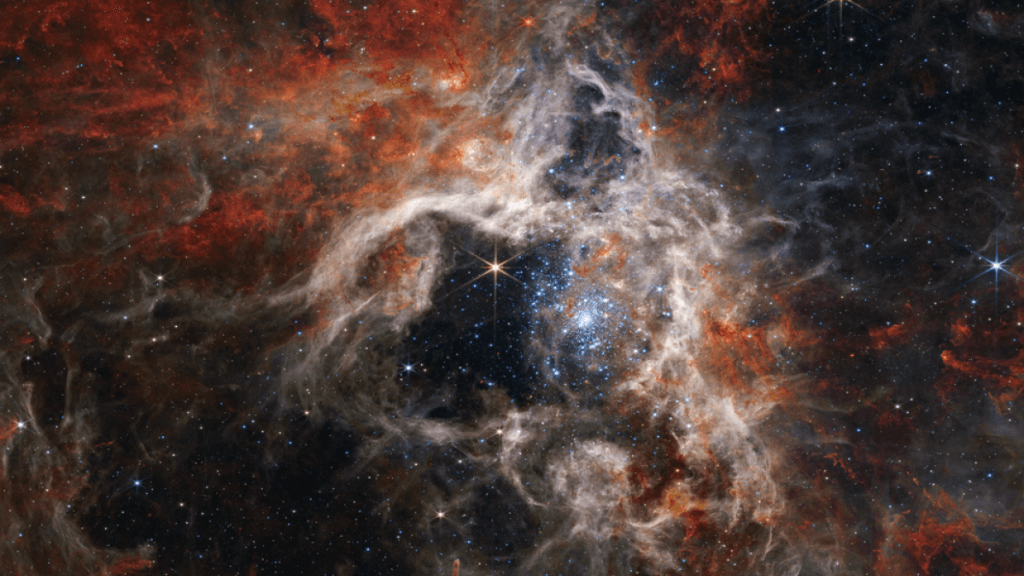The Webb telescope is revealing previously unseeable things in the cosmos.
Astronomers running the most powerful space telescope ever built — at NASA, the European Space Agency, and the Canadian Space Agency — recently released an unprecedented view of the Tarantula Nebula, a giant region of swirling gas and dust. This nebula, at some 161,000 light-years away (which is relatively close cosmically speaking), is also “home to the hottest, most massive stars known,” explains NASA.
In the image above and below you can peer into a great cavity in the nebula where you’ll spot the vivid, massive stars. They appear pale blue. “Blistering radiation” emanating from these hot stars blew the dust and gas away, allowing telescopes like Webb to more easily peer inside.
Importantly, the James Webb Space Telescope, which captures unparalleled amounts of light from deep space and views wavelengths that aren’t visible to our eyes (infrared light), revealed thousands of massive, never-seen-before stars in that central cluster.
Astronomers and planetary scientists are certainly thrilled about Webb’s latest images. “NEW #JWST IMAGE JUST DROPPED DO YOURSELF A FAVOUR CLICK ON THE PIC TO MAKE IT FULL SCREEN,” tweeted planetary scientist Paul Byrne. “This is 30 Doradus—the Tarantula Nebula—like we’ve never seen it before.”
The Tarantula Nebula, unlike star-forming regions in our Milky Way galaxy, is making stars at an especially “furious” rate, explains NASA, similar to nebulas when the universe was in its early stages. Viewing the Tarantula Nebula, then, allows astronomers a close view of a dynamic star-creating process from eons ago.
Want more science and tech news delivered straight to your inbox? Sign up for Mashable’s Top Stories newsletter today.
Webb, stationed 1 million miles away from Earth, is expected to reveal a plethora of new insights about the universe. Here’s how Webb will achieve unparalleled things:
-
Giant mirror: Webb’s mirror, which captures light, is over 21 feet across. That’s over two and a half times larger than the Hubble Space Telescope’s mirror. Capturing more light allows Webb to see more distant, ancient objects. The telescope will peer at stars and galaxies that formed over 13 billion years ago, just a few hundred million years after the Big Bang.
“We’re going to see the very first stars and galaxies that ever formed,” Jean Creighton, an astronomer and the director of the Manfred Olson Planetarium at the University of Wisconsin–Milwaukee, told Mashable last year.
-
Infrared view: Webb is primarily an infrared telescope, meaning it views light in the infrared spectrum. This allows us to see far more of the universe. Infrared has longer wavelengths than visible light, so the light waves more efficiently slip through cosmic clouds in space; the light doesn’t as often collide with and get scattered by these densely-packed particles. Ultimately, Webb’s infrared eyesight can penetrate places Hubble can’t.
“It lifts the veil,” said Creighton.
-
Peering into distant exoplanets: The Webb telescope carries specialized equipment, called spectrometers, that will revolutionize our understanding of these far-off worlds. The instruments can decipher what molecules (such as water, carbon dioxide, and methane) exist in the atmospheres of distant exoplanets — be they gas giants or smaller rocky worlds. Webb will look at exoplanets in the Milky Way galaxy. Who knows what we’ll find?
“We might learn things we never thought about,” Mercedes López-Morales, an exoplanet researcher and astrophysicist at the Center for Astrophysics-Harvard & Smithsonian, told Mashable in 2021.

